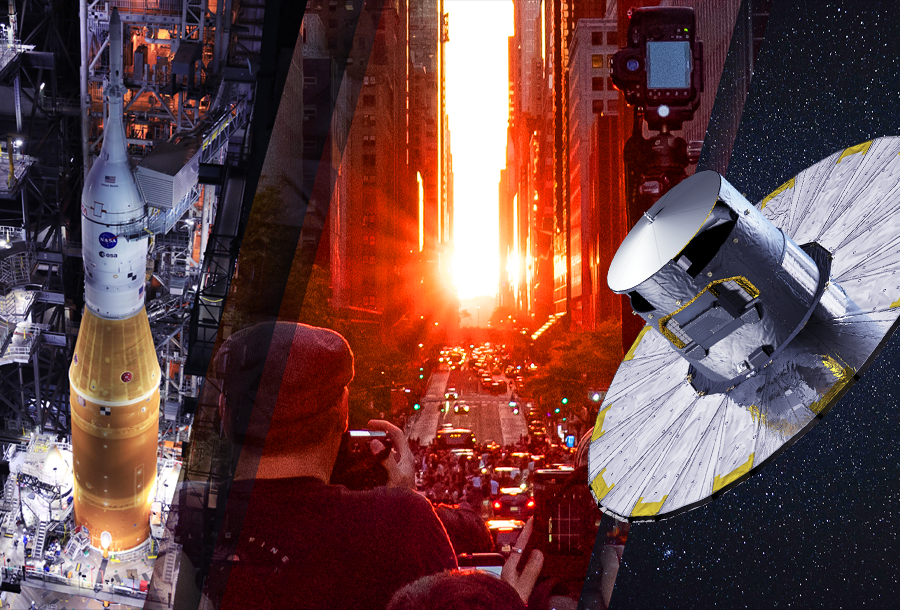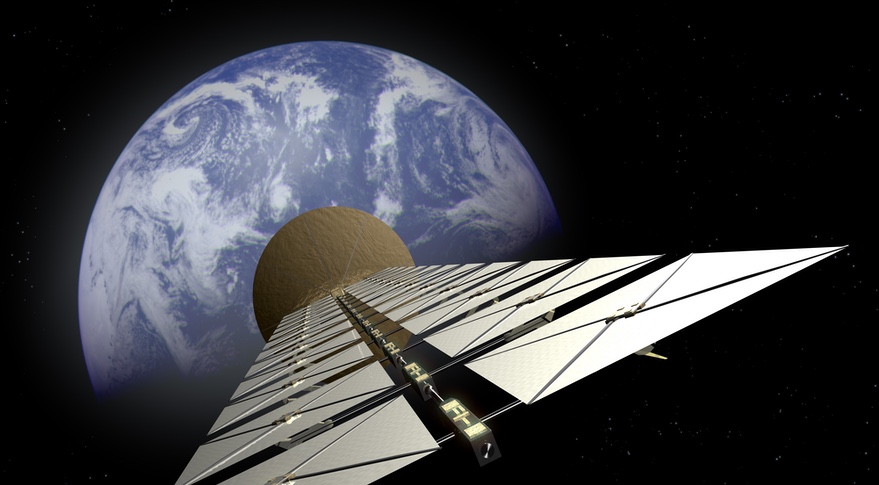Selection of space news for breakfast: In New York, the first “Manhattanhenge” was observed this year. NASA will study the benefits of obtaining solar energy from space, and ESA wants to create a satellite constellation to monitor space weather.

Next attempt to refuel the SLS is scheduled for June 19
NASA has published a new schedule of final tests of the superheavy SLS rocket, which will be involved in the Artemis I mission. On June 5, the carrier will leave the Vehicle Assembly Building and head to the launch pad. On June 19, engineers will try to fully refuel the rocket and hold a dress rehearsal of the pre-launch countdown.
China rolls out rocket for Shenzhou-14 crewed mission
China is preparing to launch three astronauts to its Tiangong space station to oversee a crucial phase of construction of the orbital outpost. The Long March 2F rocket was rolled out to the pad at Jiuquan Satellite Launch Center in the Gobi Desert early on May 29. The 62-meter-long rocket was transferred vertically across the roughly 1,500 meters from the assembly building to the pad at no faster than 30 meters per minute.
Market News

NASA to reexamine space-based solar power
NASA is starting a study to reexamine the viability of space-based solar power, a long-touted solution to providing power from space that may be getting new interest thanks to technological advances and pushes for clean energy.
Starlink approved in Nigeria and Mozambique, says Elon Musk
SpaceX CEO Elon Musk announced the regulatory clearance in Africa via Twitter a few hours after tweeting that Starlink had been approved in the Philippines, the first country in Southeast Asia to grant it permission to provide services. Starlink’s regulatory approvals mean the low Earth orbit network “is now licensed on all seven continents,” SpaceX’s Twitter account added.
Open Cosmos signs contract with ESA
British small satellite startup Open Cosmos said it has secured European Space Agency funding to develop plans for a space weather monitoring constellation. ESA awarded a 5.2 million euro ($5.6 million) contract to Open Cosmos, which is the technical lead for a European consortium comprising engineering, research and academic organizations for the proposed three-satellite NanoMagSat network.
SpaceX’s Starship work in South Texas spurs lawsuit over Boca Chica beach access
The Sierra Club and others have filed suit against Texas officials over Boca Chica closures during SpaceX Starship activities. The Sierra Club, the Carrizo/Comecrudo Tribe of Texas and non-profit Save RGV have joined together in a lawsuit against the Texas General Land Office, Texas land commissioner George P. Bush and Cameron County in Texas for closing Boca Chica Beach periodically for SpaceX.
Interesting

The first “Manhattanhenge” of 2022 could be seen this weekend in New York
Every year around May 29 and 30 – and again around July 12 and 13 – people in New York City look forward to Manhattanhenge. It’s a phenomenon where the sunset aligns perfectly with east-west oriented streets of Manhattan, particularly along 14th, 23rd, 34th, 42nd and 57th Streets.
On This Day In Space: May 30, 1975: European Space Agency established
The European Space Agency was created as a merger of the European Launcher Development Organization, or ELDO, and the European Space Research Organisation, ESRO. Both ELDO and ESRO were established in the 1960s to unify the space-related activities of European nations.
After World War II, a lot of European rocket scientists left to work in the United States. This made it difficult for small countries in Europe to compete with the space programs of the U.S. and the Soviet Union, which were the two big superpowers in the world of spaceflight.
Gaia Observatory discovered hot Jupiter
During the analysis of data collected by the Gaia Space Observatory, astronomers discovered a previously unknown hot Jupiter. The peculiarity of the find is that it is made by the transit method. To date, this is the second exoplanet found by Gaia using this method. The Gaia Observatory was launched in 2013. Its main purpose is to compile a detailed map of the distribution of stars in the Milky Way. To do this, the telescope measures the positions, direction of motion and spectral classes of about a billion luminaries. But Gaia can also be used for other tasks, including the study of exoplanets.
Why Did Mars Dry Out?
Mars once ran red with rivers. The telltale tracks of past rivers, streams and lakes are visible today all over the planet. But about three billion years ago, they all dried up – and no one knows why. Many scientists had assumed that losing carbon dioxide from the atmosphere, which helped to keep Mars warm, caused the trouble. But the new findings, published in Science Advances, suggest that the change was caused by the loss of some other important ingredient that maintained the planet warm enough for running water.
Physicists predict Earth will become a chaotic world, with dire consequences
Humans aren’t just making Earth warmer, they are making the climate chaotic, a stark new study suggests. The new research, which was posted to the preprint database arXiv (opens in new tab), draws a broad and general picture of the full potential impact of human activity on the climate. It makes a general sketch of where humanity is heading.
According to the authors of the study, scientists from the Faculty of Physics and Astronomy of the University of Porto in Portugal, people need to stop using fossil fuels uncontrollably to stop chaotic climate change.
Follow us on Twitter to get the most interesting space news in time
https://twitter.com/ust_magazine

